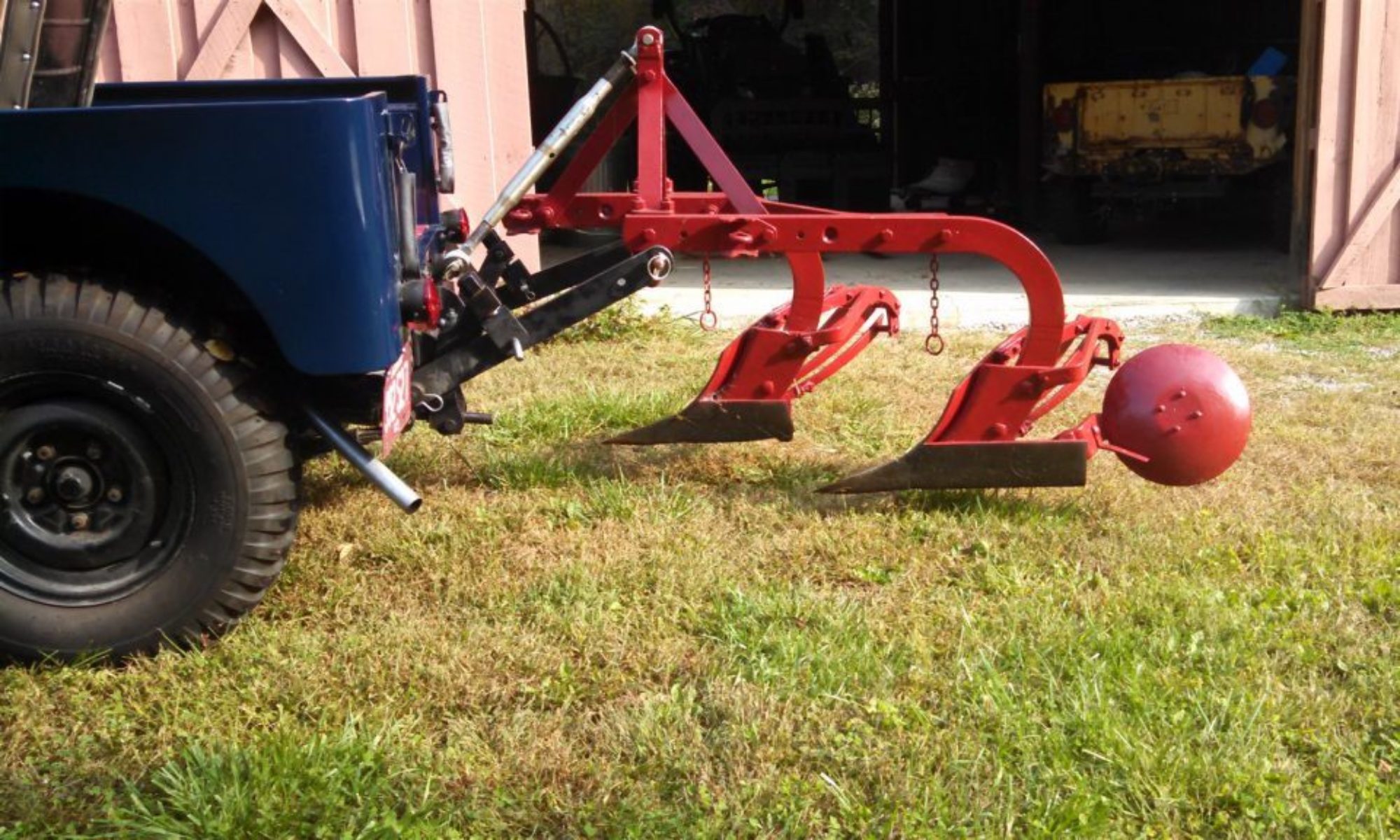by Clint Dixon
Chapter 2
No sooner had production of the Monroe Lift began, than photos began to appear in sales literature that clearly showcased Ferguson plows attached to and being pulled by the Universal Jeep. Willys-Overland, however, never officially acted upon the earlier reports that it was slated to become an approved sub-distributor for Ferguson implements. This is not surprising considering the recent split between Ferguson and Ford during July of the previous summer in 1947.
Rebounding from the split, Ferguson was well into planning the production of his own tractor. Needing implements to sell alongside of this new tractor, he was holding a tight grip on his implement patents and the exclusive binding agreements he had with the actual vendors who had produced the implements and/or parts for use with the Ford. Monroe executives were undeterred. They had another plan that assured they would not have to rely upon Willys, or even Ferguson, to supply implements to attach to their Lift. The Monroe Auto Equipment Company took the reins and established itself as the sole implement distributor for Willys through the purchase of a new subsidiary.
On December 27, 1947, Monroe purchased the Newgren Company with the new acquisition thus becoming a subsidiary of Monroe.[1] Founders George Newlin and Henry Green stayed on with Newgren as president and vice president, respectfully. With the new purchase Monroe immediately gained an established source of farm implements. With that came a well-defined dealer network as well as a list of suppliers to actually produce the equipment. Nearly all of these suppliers were the very same vendors who were now in the uncomfortable position of supplying parts and complete implements, not only to Newgren, but also to Ferguson and the to the newly created Dearborn implement division of Ford Motors. It was a wild dash for these vendors to circumvent the existing Ferguson patents and mutual agreements while keeping up with the three-way demand.[2]
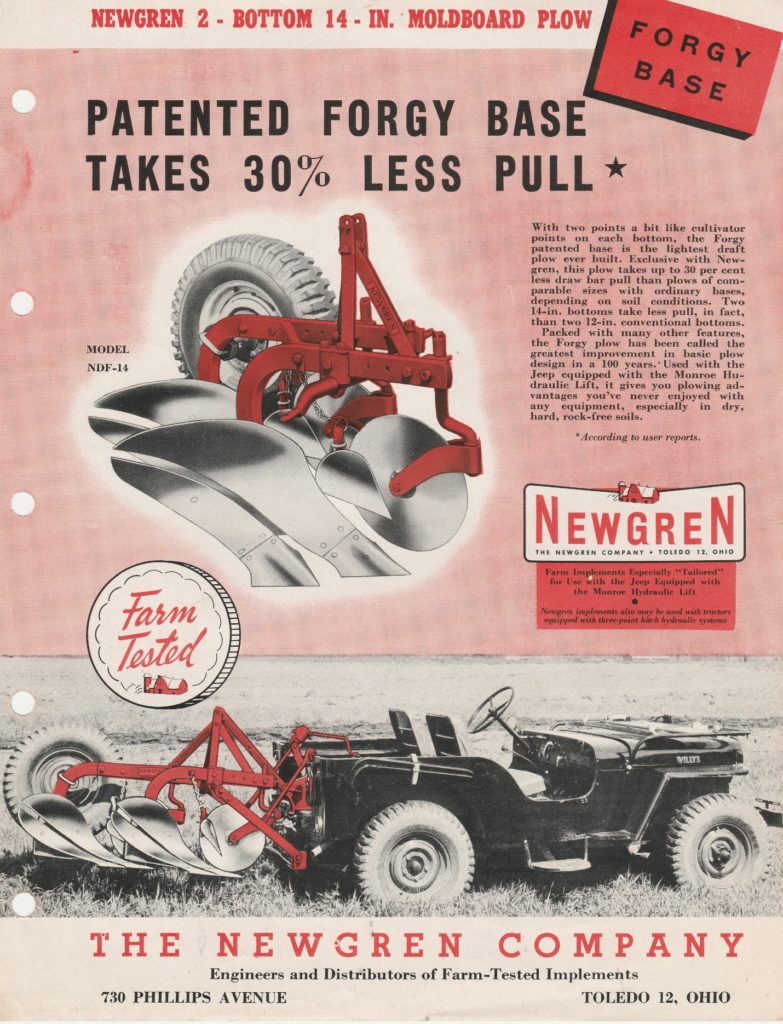
With Monroe now in control of Newgren, one of the first decisions made by the parent company was to discontinue the Newgren lift in favor of marketing their own unit. Along with this move came needed design changes in the implements themselves. With Newgren branded implements now paired with Monroe Lifts, it was necessary to increase mast heights in order to allow proper implement attachment and operation with the Monroe geometry. This geometry more closely resembled that which was employed by lifts found on the Ford and Ferguson tractors and that which would become the future “Category I” standards – somewhat different from that of the Jabez Love designed Newgren lift.
Soon after the purchase, Brouwer’s son, Charles S. McIntyre III (Chuck) was quickly appointed to the position of Area Sales Manager for Newgren. His responsibilities were to oversee Michigan, Ohio, Indiana, and Kentucky. During the following summer he would travel the region calling upon Willys-Overland distributors with a focus on promoting the use of the Monroe Lift with the Willys Jeeps.[3] Things were quickly changing however.
On June 12, 1948 the New York Times reported that A.W. Pickett Inc. of New York City had been appointed exclusive distributor of the expanded Newgren line of farm implements. Less than a month later, newspapers were reporting that the American Bantam Car Company of Butler, Pennsylvania had purchased the Newgren Company from Monroe. Negotiations between Monroe and Bantam leading up to the sale actually began in February of 1948, just a short couple of months after Monroe’s initial purchase.[4] With the deal Bantam acquired all of the Newgren stock from Monroe, Monroe would receive new class B stock of Bantam, and the three McIntyre brothers Brouwer, Charles Jr., and William were named directors of Bantam with Brouwer as Chairman of the Board. The board quickly elected Brouwer to the position of President, William to the position of Executive Vice President, and Charles Jr. to Vice President.[5]
On September 20th Brouwer announced to stockholders that the Newgren Company had been moved from Toledo to Butler PA.[6] On October 1, 1948 Charles Jr. was elected as the new President of Newgren after previous President George Newlin resigned his position as head of the company in order to pursue a career of breeding purebred Guernsey cattle. He would become manager of Wood Acres Farm of Princeton, N.J. George however was staying on as a member of the Board of Directors of the Newgren division.[7],[8]
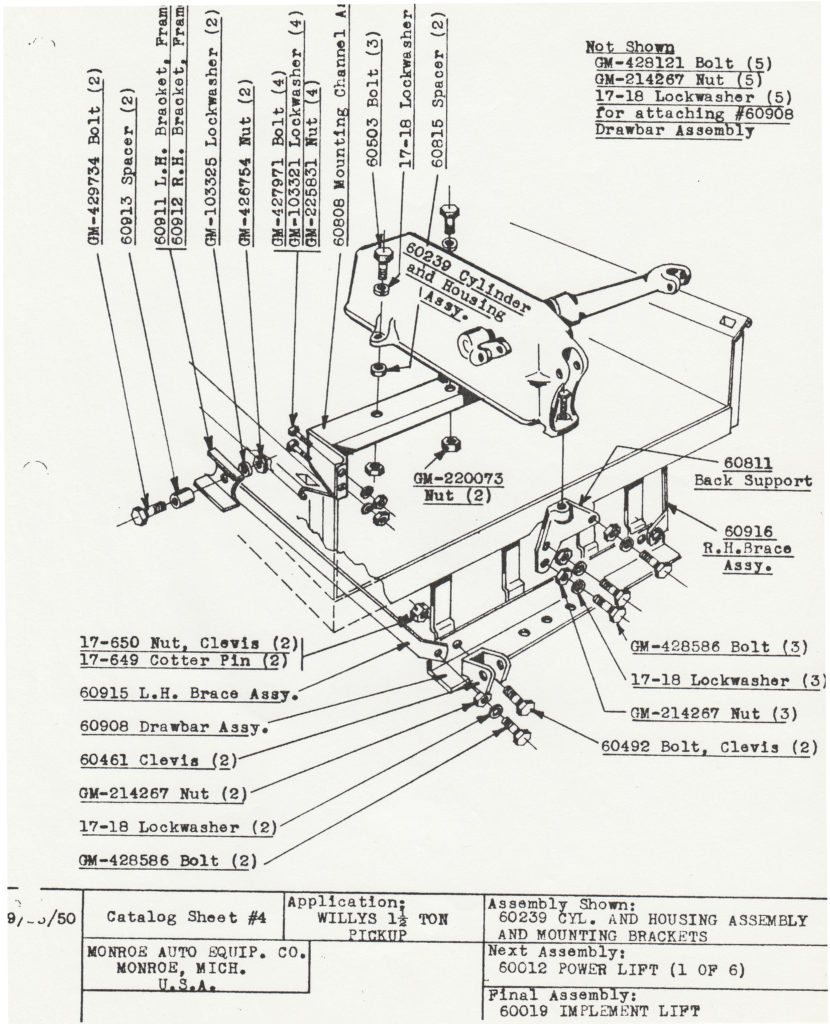
Charles Smith and William Esdale were finally granted a patent for the Monroe Lift on February 2, 1954, almost exactly six years after having applied for it on February 14, 1948. The official title of their invention was “Control Valve for Fluid Operated Lifts.” They were both assignors to Monroe and the patent number assigned was #2,667,745. Another patent was granted to Robert Green and Spencer Brackett, again, both assignors to Monroe slightly earlier on January 5th of the same year. This patent, #2,664,805 was actually for a resilient suspension device that was designed to improve function of the Monroe Lift System.
The Universal Jeep, Farm Jeep, and Jeep Tractor were not the only vehicles to use the Monroe Lift. Monroe also built units to fit the Jeep pickup truck. Some of the angular geometry to components internal to the clamshell housing differed slightly on the truck version as well as the truck using a much shorter leveling crank handle than that found on the Universal.
The Le Roi Centaur AG-48 and AG-49 tractors, produced in Greenwich, Ohio, used Monroe Lift assemblies differing only slightly to those found on Jeep pickup truck. The most obvious difference was that the Monroe clamshell housing used by Le Roi had a special bracket welded to its top surface to accept mounting of the Monroe tractor seat.
Another tractor to use the Monroe Lift was the early version of the Terratrac model GT-25 crawler tractor produced by American Tractor Corp. of Churubusco, Indiana. A few different versions of the Monroe Lift appear in factory ATC literature. Most parts were shared with other Monroe units with the exception that ATC did not use the cast Monroe clamshell to protect and mount the hydraulic cylinder.
And finally, the 1-ton four-wheel-drive Power-Wagon, a product of Chrysler’s Dodge Truck Division, could also be fitted with its own version of the Monroe Lift Kit. This kit used the same short leveling crank handle as found on the Jeep pickup and Le Roi Centaur and no clamshell for mounting the cylinder. The Power-Wagon did require a much more complex substructure mounted to the rear of the vehicle however. All the above mentioned vehicles are also shown in vintage literature pulling attached Newgren implements. One of the largest demonstrations of Power-Wagons working the soil and outfitted with Monroe Lifts took place at the McIntyre family farm near Woodland, Georgia on December 12, 1949.[9],[10]
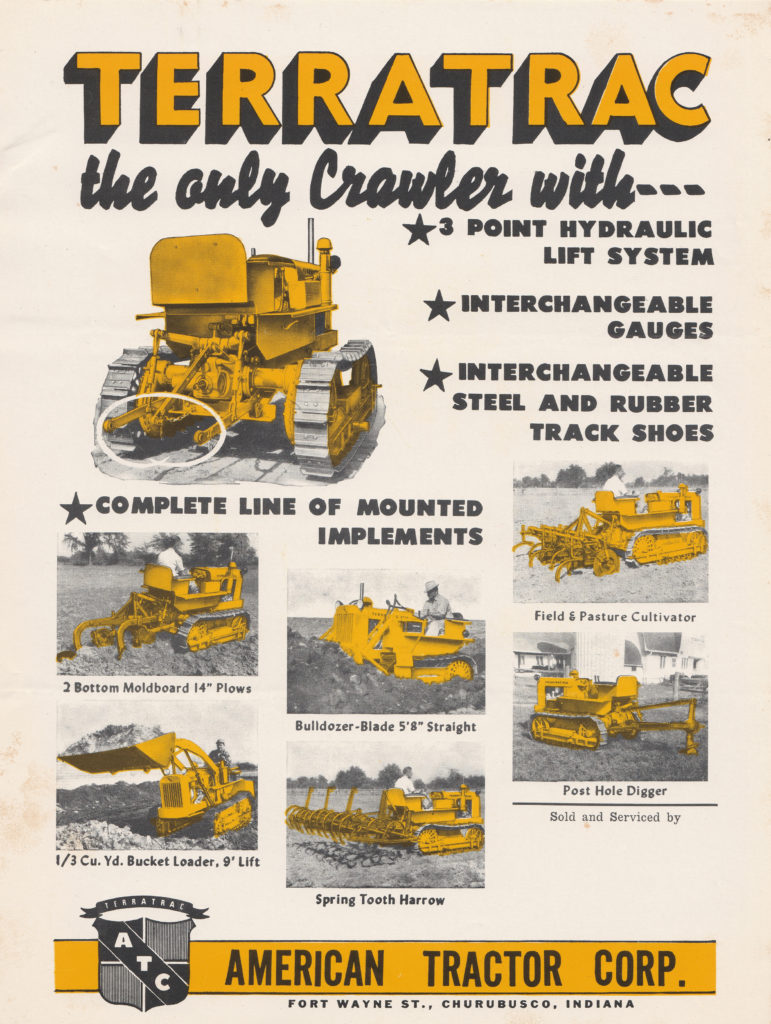
Massey-Harris model 21 “Colt”, model 22, and model 23 “Mustang” tractors of the same time period used the unique short Monroe lower links with one additional hole added on the link to the operator’s left. This additional hole was necessary for mounting the unique Massey-Harris stabilizer bar. The Farmaster tractor was reported as using a Monroe valve and cylinder on its hydraulic power unit and lift system .[11],[12] Sheppard model S2 and S3 model diesel tractors out of Hanover, Pennsylvania listed Monroe work cylinders as being used on both tractors and implements.[13]
The 1948 cost of a complete Monroe Hydraulic Lift to fit the Universal Jeep totaled $193.00 dealer’s price, with a suggested list price of $240.00, F.O.B. Shipping weight of the complete kit was right at 175 lb.[14]
The total price tag, effective 1950, on a Monroe Hydraulic Lift System ordered from the American Tractor Corporation to fit the Terratrac GT-25 was $265.00. Shipping weight of the unit was 250 lb. and there was an additional charge of $21.00 for those opting for factory installation.[15]
The total 1951 cost of a complete Monroe Hydraulic Lift, factory installed, on the Dodge 1-ton Power-Wagon was $439.70.[16]
In 1949 Chuck McIntyre left Newgren and returned to the Monroe Auto Equipment Company, taking the position of Service Manager. He reports in personal letters to the author that it was shortly after this time that the family executives removed the responsibility of distributing the Monroe Lift and implements from Newgren and handed it directly over to Willys-Overland. In 1950, volume #103 edition of Automotive Industries reported on the formation of a new department within Willys. It was to be named the Farm Sales Department. The new department was given complete control over the procurement, field testing, and distribution of implements as well as the Monroe Lift itself. Robert Green and William Smelker both left Newgren and took positions as assistants to Charles R. Vincent who was named manager of the new Willys department.[17]
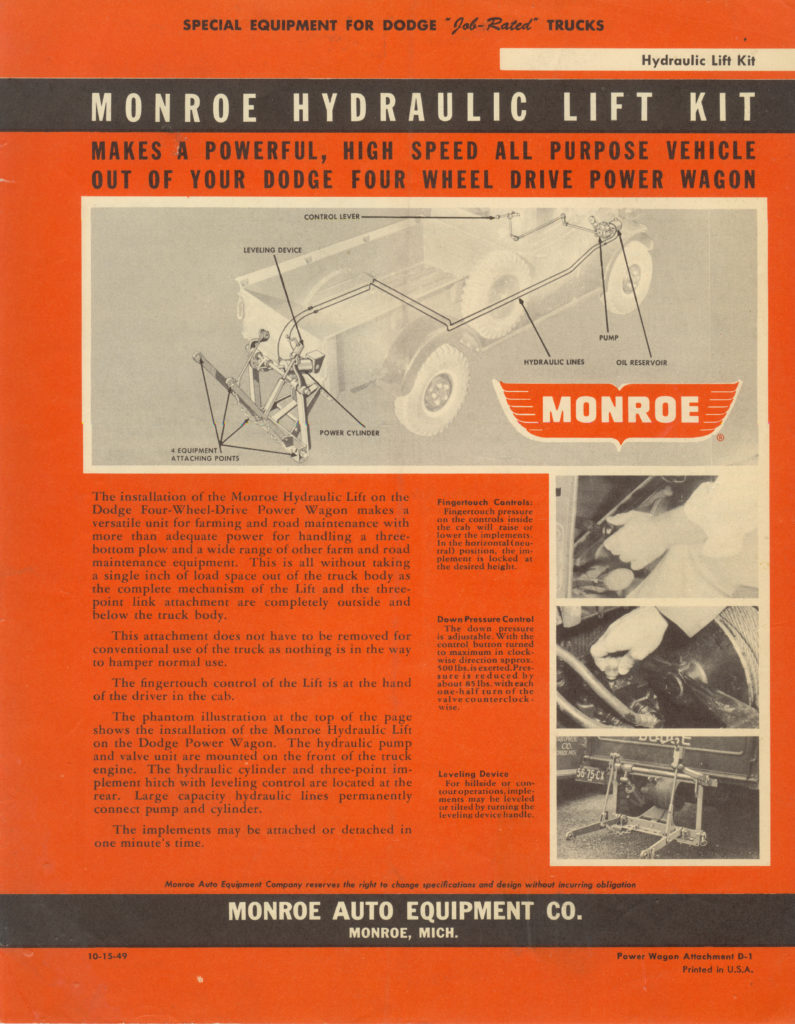
In 1950 Willys-Overland was actively placing magazine ads enticing established farm implement dealers to increase their offerings by purchasing franchises to sell the Willys Jeeps and implements.[18],[19] Increasingly throughout the 1950’s, less and less reference was made to the Monroe Lift kit in Willys-Overland and Chrysler corporation sales literature. And virtually no mention appears in Monroe literature after they handed over responsibility of distributing the system to Willys. It appears that from the beginning Dodge, Le Roi, and ATC had always been responsible for distributing their own unique versions of the Monroe Lift.
By the mid 1950’s, the Monroe Auto Equipment Company was consolidating its business. It was redirecting its focus with the aftermarket shock absorber market now on target. Manufacturing of truck and tractor seats, steering components, and hydraulics operations were all being drastically reduced or discontinued altogether. Tractor manufacturers were designing and marketing their own unique versions of hydraulic lifting and attaching systems. Farmers were finding that both tractors and trucks were modernizing and improving at an alarming rate, as well as agriculture in general. The idea, fostered just a few years earlier, that one vehicle was needed that could perform multiple tasks was quickly fading. But there was still one more newcomer on the horizon. And what was once old, would be new again.
[1] Cathy Cunningham, American Austin Bantam Club, personal correspondence
[2] Chester Peterson Jr. & Rod Beemer, Ford Tractor Implements, MBI Publishing Company 1998
[3] C.S. (Chuck) McIntyre III, Retired President MAECO, personal correspondence
[4] Cathy Cunningham, American Austin Bantam Club, personal correspondence
[5] Toledo Blade, Monroe Firm Acquires Control Of Bantam Car, July 5, 1948
[6] Toledo Blade, Bantam Subsidiary Moves From City, Newgren Production Starts In Butler, Pa. September 20, 1948
[7] Youngstown Vindicator, McIntyre Heads Newgren, October 1, 1948
[8] The New York Times, New President for Newgren, October 2, 1948
[9] Dodge Power-Wagon Dealer Sales Information, Subject: Power Wagon demonstration at Woodland, Ga. And McGregor, Texas, December 1949
[10] Implement & Tractor, Dodge Power-Wagon Pulls Field Implements, January 21, 1950
[11] Red Tractor Book, Tractor Components And Equipment Data, 1950-51, page 198
[12] Ibid, page 263
[13] Ibid, page 266
[14] The Newgren Company, Dealers Confidential Price List, October 14, 1948
[15] American Tractor Corporation, Suggested Retail Price List, December 13, 1950
[16] Chrysler Corporation, Dodge Division, Detroit 31, Mich., Invoice No. T700124, January 5, 1951
[17] Automotive Industries, Vol. 103, 1950
[18] Implement & Tractor, To Market Jeep Through Farm Equipment Dealers, March 4, 1950, page 42
[19] Ibid, Willys-Overland ad with coupon, page 56
